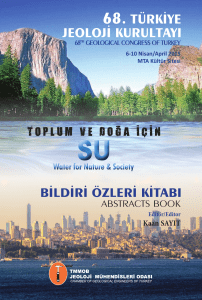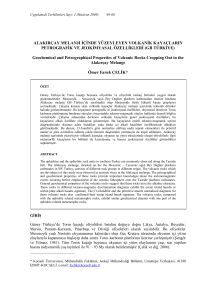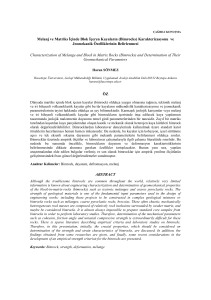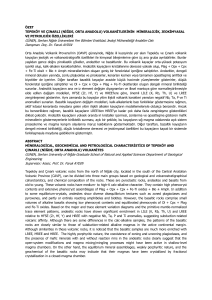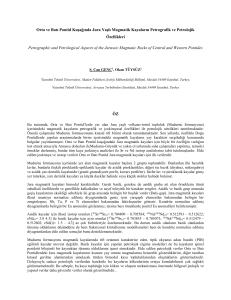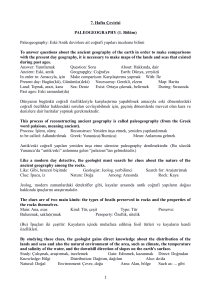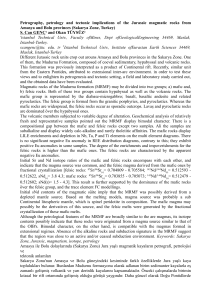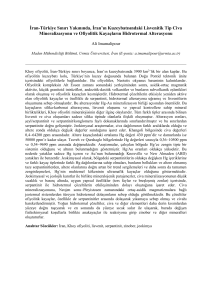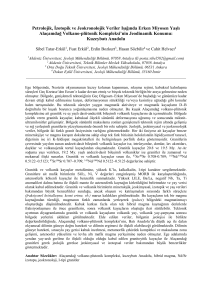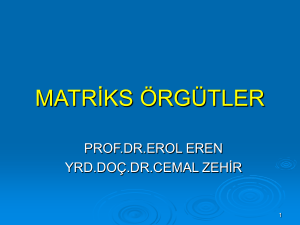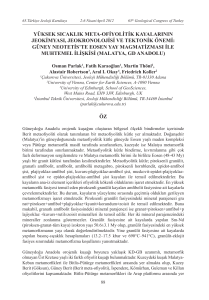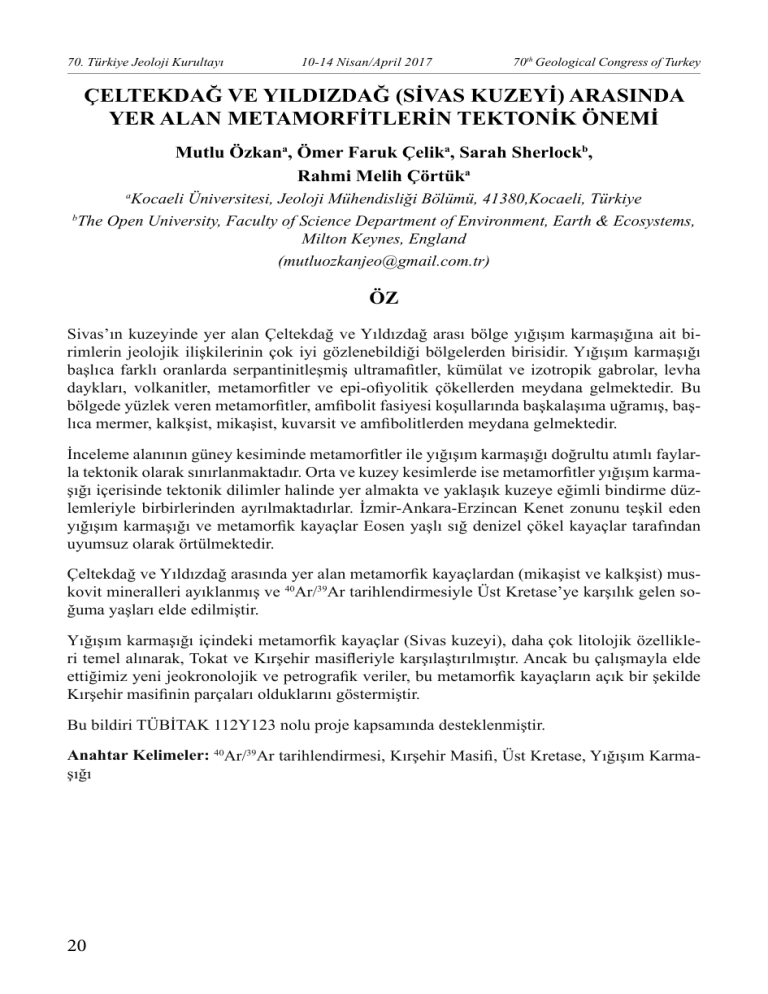
70. Türkiye Jeoloji Kurultayı
10-14 Nisan/April 2017
70th Geological Congress of Turkey
ÇELTEKDAĞ VE YILDIZDAĞ (SİVAS KUZEYİ) ARASINDA
YER ALAN METAMORFİTLERİN TEKTONİK ÖNEMİ
Mutlu Özkana, Ömer Faruk Çelika, Sarah Sherlockb,
Rahmi Melih Çörtüka
Kocaeli Üniversitesi, Jeoloji Mühendisliği Bölümü, 41380,Kocaeli, Türkiye
The Open University, Faculty of Science Department of Environment, Earth & Ecosystems,
Milton Keynes, England
([email protected])
a
b
ÖZ
Sivas’ın kuzeyinde yer alan Çeltekdağ ve Yıldızdağ arası bölge yığışım karmaşığına ait birimlerin jeolojik ilişkilerinin çok iyi gözlenebildiği bölgelerden birisidir. Yığışım karmaşığı
başlıca farklı oranlarda serpantinitleşmiş ultramafitler, kümülat ve izotropik gabrolar, levha
daykları, volkanitler, metamorfitler ve epi-ofiyolitik çökellerden meydana gelmektedir. Bu
bölgede yüzlek veren metamorfitler, amfibolit fasiyesi koşullarında başkalaşıma uğramış, başlıca mermer, kalkşist, mikaşist, kuvarsit ve amfibolitlerden meydana gelmektedir.
İnceleme alanının güney kesiminde metamorfitler ile yığışım karmaşığı doğrultu atımlı faylarla tektonik olarak sınırlanmaktadır. Orta ve kuzey kesimlerde ise metamorfitler yığışım karmaşığı içerisinde tektonik dilimler halinde yer almakta ve yaklaşık kuzeye eğimli bindirme düzlemleriyle birbirlerinden ayrılmaktadırlar. İzmir-Ankara-Erzincan Kenet zonunu teşkil eden
yığışım karmaşığı ve metamorfik kayaçlar Eosen yaşlı sığ denizel çökel kayaçlar tarafından
uyumsuz olarak örtülmektedir.
Çeltekdağ ve Yıldızdağ arasında yer alan metamorfik kayaçlardan (mikaşist ve kalkşist) muskovit mineralleri ayıklanmış ve 40Ar/39Ar tarihlendirmesiyle Üst Kretase’ye karşılık gelen soğuma yaşları elde edilmiştir.
Yığışım karmaşığı içindeki metamorfik kayaçlar (Sivas kuzeyi), daha çok litolojik özellikleri temel alınarak, Tokat ve Kırşehir masifleriyle karşılaştırılmıştır. Ancak bu çalışmayla elde
ettiğimiz yeni jeokronolojik ve petrografik veriler, bu metamorfik kayaçların açık bir şekilde
Kırşehir masifinin parçaları olduklarını göstermiştir.
Bu bildiri TÜBİTAK 112Y123 nolu proje kapsamında desteklenmiştir.
Anahtar Kelimeler: 40Ar/39Ar tarihlendirmesi, Kırşehir Masifi, Üst Kretase, Yığışım Karmaşığı
20
70. Türkiye Jeoloji Kurultayı
10-14 Nisan/April 2017
70th Geological Congress of Turkey
TECTONIC IMPORTANCE OF THE METAMORPHIC ROCKS
LOCATED BETWEEN ÇELTEKDAĞ AND YILDIZDAĞ
(NORTHERN SİVAS)
Mutlu Özkana, Ömer Faruk Çelik a, Sarah Sherlockb,
Rahmi Melih Çörtüka,
Kocaeli University, Dep. of Geol. Eng., 41380,Kocaeli, Turkey
The Open University, Faculty of ScienceDepartment of Environment, Earth &Ecosystems,
Milton Keynes, England
([email protected])
a
b
ABSTRACT
An area between Çeltekdağ and Yıldızdağ, which is located to the north of Sivas, is one of the
best areas to observe the geological relationships of the accretionary complex. The accretionary complex consists mainly of ultramafites with varying degrees of serpentinization, cumulate and isotropic gabbros, sheeted dikes, volcanites, metamorphic rocks and ephi-ophiolitic
sediments. The metamorphic rocks in this area, are composed mainly of marbles, calcschist,
micaschist, quartzite and amphibolites, and are characterized by amphibolite facies condition.
The metamorphic rocks and the accretionary complex are tectonically delimited by the strike-slip faults in the southern part of the investigated area. The metamorphic rocks in the accretionary complex are observed as tectonic slices in the central and northern part of the study
area and are separated from the other units of the accretionary complex by the north dipping
thrust faults. The accretionary complex of the İzmir-Ankara-Erzincan suture zone and the metamorphic rocks are unconformably covered by the shallow marine sediments.
The muscovite minerals separated from the metamorphic rocks (micaschist and calcschist)
which are located between Çeltekdağ and Yıldızdağ, yielded Late Cretaceous cooling ages
based on the 40Ar/39Ar dating method.
The metamorphic rocks in the accretionary complex (Northern part of Sivas) have compared
with the Tokat and Kırşehir Massifs, based on their lithological properties. However, our new
geochronological and petrographic data indicate clearly that these rocks are a part of the
Kırşehir Massif.
This study was funded by TÜBİTAK number of project 112Y123
Keywords: 40Ar/39Ar dating, Kırşehir Massif, Late Cretaceous, Accretionary Complex
21

